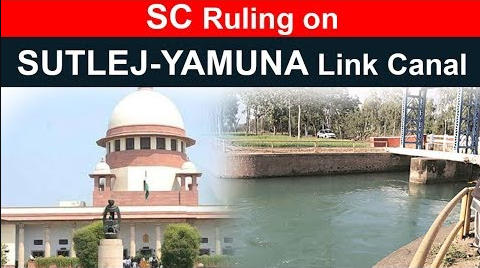Table of Contents
Q) Consider the following statements regarding inter-state water dispute
- Article 262 of the constitution empowers the state legislatures to make laws for the adjudication of inter-state water dispute.
- The Inter-State Water Disputes Act 1956 was enacted to deal with inter-state water disputes.
- The members of tribunal are appointed by the President of India.
Which of the statement given above is / are correct.
- 1 & 2 only
- 2 & 3 only
- 2 only
- All of the above

HISTORY OF SYL CANAL
- The state of Haryana was created from Punjab in 1966.
- This led to the problem of giving Haryana its share of river waters.
- GOI issued a notification on March 24, 1976 and Haryana was allocated 3.5 MAF of waters.
- The total length of the canal was proposed to be 212 km. of which 121 km. in Punjab & 91 km. in Haryana.
- Haryana completed the work in June 1980.
- However, Punjab did not start the work.
- In 1981 agreement was entered among Punjab, Haryana and Rajasthan to re-allocate the waters of Ravi and Beas.
- To enable Haryana to use its share of waters, Union Government started Sutlej Yamuna Link (SYL) canal Project in 1982.
- This project was the product of 1981 agreement.

RAJIV-LONGOWAL ACCORD
- After laying the foundation, the Shiromani Akali Dal (SAD) launched an agitation against the canal under the leadership of Sant Harchand Singh Longowal.
- In August 1982, the agitation was converted into a “Dharam Yudh (holy war)”.
- The agitation took a violent turn, plunging the state into chaos.
- On July 24, 1985, Prime Minister Rajiv Gandhi and Longowal signed the Punjab accord in New Delhi.
- The agreement called for completion of the canal by August 1986.
- The SS Barnala-led SAD government started the work and 90% of it was completed.
BUT AGAIN CONSTRUCTION STOPPED
- The construction work stopped when Sikh militants gunned down two senior engineers and 35 labourers working on the canal.
- A decision was taken to rope in the Border Roads Organisation, but again nothing moved forward.
- In 1996, Haryana filed a plea in the Supreme Court, seeking directions for Punjab to complete the canal.
THE PUNJAB TERMINATION OF AGREEMENTS ACT,2004
- Supreme Court in January 2002 and June 2004, ordered the remaining portion of the canal to be completed.
- In response to SC order, Punjab Assembly passed The Punjab Termination of Agreements Act, 2004, cancelling its water-sharing agreements.
SC SCRAPPING THE ACT
- In March 2016 SC took up the matter.
- Meanwhile the Punjab legislature passed another act, the Punjab SutlejYamuna Link Canal (Rehabilitation and Re-vesting of Proprietary Rights) Bill 2016, which seeks to restore the land acquired for the canal, back to the farmers free of cost.
- Even though the Governor did not give assent to the bill.
- After that SC scrapped the 2004 act and asked to maintain the status quo.

SO WHAT NOW?
- Supreme Court recently directed the states of Punjab and Haryana and the Centre to resolve the Sutlej Yamuna Link Canal issue by Sept. 3.
- The apex court directed the two states and the Centre to convene a meeting and find an amicable solution to the issue.
ARGUMENTS AGAINST PUNJAB:-
- The Punjab govt. can not unilaterally cancel the Inter-state water sharing agreement which was signed among states and Centre.
ARGUMENTS FOR PUNJAB:-
- Ground realities over past six decades have completely changed the scenario regarding water availability in Punjab.
WAY FORWARD
- There seems to be distrust and short-sightedness behind the competitive politics over the SYL canal.
- Both States have serious water issues such as sinking water table due to over exploitation, pollution of water resources etc.
- Hence there is a need to move away from unsustainable and waterintensive cropping pattern.
- At the same time Punjab can’t unilaterally cancel the agreement and hence must cooperate with Haryana as it was part of Punjab.
Q) Consider the following statements regarding inter-state water dispute
- Article 262 of the constitution empowers the state legislatures to make laws for the adjudication of inter-state water dispute.
- The Inter-State Water Disputes Act 1956 was enacted to deal with inter-state water disputes.
- The members of tribunal are appointed by the President of India.
Which of the statement given above is / are correct.
- 1 & 2 only
- 2 & 3 only
- 2 only
- All of the above
Latest Burning Issues | Free PDF






















 WhatsApp
WhatsApp